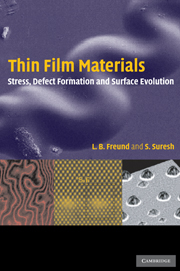Book contents
- Frontmatter
- Contents
- Preface
- 1 Introduction and Overview
- 2 Film stress and substrate curvature
- 3 Stress in anisotropic and patterned films
- 4 Delamination and fracture
- 5 Film buckling, bulging and peeling
- 6 Dislocation formation in epitaxial systems
- 7 Dislocation interactions and strain relaxation
- 8 Equilibrium and stability of surfaces
- 9 The role of stress in mass transport
- References
- Author index
- Subject index
8 - Equilibrium and stability of surfaces
Published online by Cambridge University Press: 06 July 2010
- Frontmatter
- Contents
- Preface
- 1 Introduction and Overview
- 2 Film stress and substrate curvature
- 3 Stress in anisotropic and patterned films
- 4 Delamination and fracture
- 5 Film buckling, bulging and peeling
- 6 Dislocation formation in epitaxial systems
- 7 Dislocation interactions and strain relaxation
- 8 Equilibrium and stability of surfaces
- 9 The role of stress in mass transport
- References
- Author index
- Subject index
Summary
The role of mechanical stress in establishing the equilibrium and stability of material surfaces is the focus in this chapter. The concepts developed provide the basis for consideration of stress-driven transient evolution of surfaces, which will be taken up in the following chapter. Examples of material surfaces that are of interest include the free surface of a crystal, which may be adjacent to a vacuum or in contact with a vapor, and the interface between two crystals. In all these situations, it is assumed that each solid phase is a homogeneous elastic medium. A characterizing feature of such a solid is that there is always a well-defined reference configuration to which it returns when all external loads are removed from it. While this configuration is commonly viewed as being immutable, the focus in this chapter is on situations in which this reference configuration can change shape or size over time. Physical processes by which this can occur involve the addition, rearrangement and removal of mass which can proceed, for example, by means of condensation/evaporation, surface diffusion, grain boundary diffusion or grain boundary migration. These processes are typically very slow, and they are not usually taken into account in applications other than material processing, a case in which stress usually plays a minor role. However, in systems with very small size scale and high temperature, stress of large magnitude can have a significant influence on the evolution of surfaces and interfaces.
- Type
- Chapter
- Information
- Thin Film MaterialsStress, Defect Formation and Surface Evolution, pp. 550 - 640Publisher: Cambridge University PressPrint publication year: 2004



